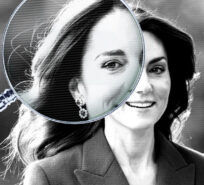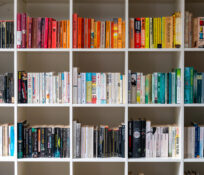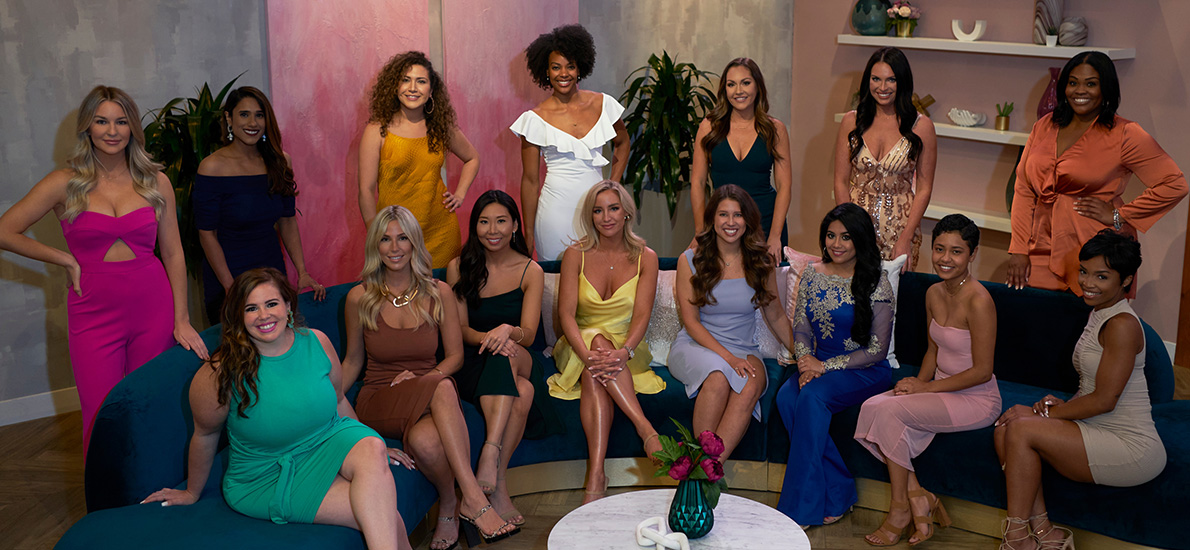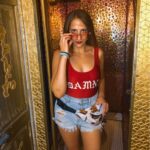Love Is Blind has returned for season two and is once again taking Netflix and the internet by storm. The reality dating show is currently trending top 2 in the U.S. on Netflix, and with the final episode now out, #LoveIsBlind is also trending on Twitter. The popular reality show revolves around 30 eligible singles talking to potential matches from a solitary room behind an opaque wall—known on the show as a “pod”—and getting engaged without ever seeing each other’s faces. As hosts Vanessa and Nick Lachey painstakingly remind us, the objective is to form a “deep emotional connection” to find out, “Is love truly blind?” A common criticism of season 1 boiled down to, “well, sure, if you’re hot and thin.” Season 2 seemed like it could have been trying to address those criticisms: the trailer depicts contestant Danielle Ruhl talking about her insecurities from growing up heavier. In the teaser, Iyanna McNeeley says, “this experiment interests me because I don’t have boobs and a butt.” And there were notably a few plus-size contestants in the pods. While season 2 gave a little more in the way of body diversity, was it enough?
Season 1 of Love Is Blind came out in February 2020 and by that April, had been watched by some 30 million people, but not everyone was enamored with the concept. Jerrica Tisdale noted in Screenrant in March 2020 of season 1’s cast, ““No one is overweight, no one has bad skin, and very few are different races.” She wrote, “Love Is Blind had the ability to challenge norms by going beyond the stereotypical looking cast,” but “Instead the show proved that yes, love is blind—if you fit into the standards of beauty.” Mathew Rodriguez wrote for Teen Vogue that season 1’s omission of fat people “stings of structural anti-fat bias.”
There is a stark lack of body diversity on reality TV in general, but part of the criticism toward this show specifically has to do with the fact that Love Is Blind isn’t just a reality dating show—or, at least, it doesn’t position itself that way. It’s a “social experiment” designed to explore if people can find lasting love without seeing a romantic prospect first. But experiments are supposed to reveal something, and is it much of a revelation to discover that attractive people can fall in love sight unseen, so long as the object of their affection also fits what’s typically associated with being conventionally attractive—thin, symmetrical features, non-disabled, well-groomed, etc.?
Season 2, which premiered on February 11, had a few contestants who stretched the mold of the types of bodies we usually see on reality TV, namely, Hope Antoniello-Foley, Chassidy Mickale, and Haseeb Husn. But any hope of seeing plus-size people fall in love was dashed by the end of the first episode, when they effectively faded from our screens and our memories. When all is said and done, Hope gets by far the most screen time—about 30 seconds altogether in the first episode. Chassidy gets 10 seconds. Haseeb gets to speak for three seconds, when he makes a crack to fellow contestant Nick Thompson about turning his notebook into an Excel spreadsheet.
Some Twitter users felt like the body positive message of including plus-size cast members was a bait-and-switch. “I was so excited to see plus-sized women on Love Is Blind and then we didn’t see them after the first episode,” wrote one Twitter user. “The show acts like it’s promoting body diversity but then perpetuates the idea that only skinny/fit people fall in love. Love is blind? Still seemed physical to me.”
Chris Coelen, creator and executive producer of Love Is Blind, tells Betches that Love Is Blind is not purposefully perpetuating any one ideal. “We throw the doors open to all kinds of people, and we don’t have time on the show to tell lots of stories of people who are there, but don’t ultimately make connections.” He says Hope, Chassidy, and Haseeb went away “because they didn’t find love, and if they had found love, we would tell those stories. We completely approach the show from a non-prejudicial place.”
Additionally, Coelen doesn’t necessarily agree that the show sets out to prove its own hypothesis. “The POV of the show is not love is blind, the POV of the show is, could it be?” he says. “I think it proves that the potential is there for us to love one another… but I think it’s also honest, in that there’s a lot of other factors in the world that are important to people.”
Hope Antoniello-Foley, one of the plus-size women cast in season 2, also says she wasn’t bothered by the cuts. “Even if it was a couple minutes each episode, I was very happy with what was shown for me,” she says. “They represented me, my looks that I think were shown a couple times—that’s me in general, that’s me in life.”
Kate Stayman-London, activist and author of One To Watch, a romance novel about a plus-size woman being the lead of a reality TV dating show (à la The Bachelorette), was disappointed by the cuts, however, and equally upset with the footage we did see. “What I didn’t anticipate was that the fat people on the show simply wouldn’t get to speak at all and would disappear without any interaction other than one fat woman getting to say that she doesn’t like to work out,” Stayman-London says.
That soundbite in particular reinforces harmful stereotypes, she says. “It is implying that any person who is fat is that because they choose to be fat, and they’re lazy. And if they would just get off their butt and go for a run or eat a vegetable once in a while, that they wouldn’t have to be fat anymore.” In fact, there was a reason Antoniello-Foley wasn’t working out around the time Love Is Blind filmed. “I had just lost 40 pounds,” she says. “I was at a calorie deficit.” She was walking a lot and “eating really clean.”
And for a show whose premise is moving past the physical, there were a number of discussions revolving around weight loss in season 2 of Love Is Blind. In the first episode, Danielle Ruhl tells Nick Thompson about how she lost 70 pounds. She says, “but now every single interaction I have with someone I’m afraid they’re gonna be like, ‘oh her arms look big here’ or ‘her stomach looks big here.’”
“I’m sure that’s painful and uncomfortable for her,” says Stayman-London, adding, “What a shitty thing to say, to say that your fear in dating is that someone might see you as looking like the way that most women look.” (The average woman in America is a size 16 or 18.)
Meanwhile, Antoniello-Foley says that she was inspired to apply for the show after getting discouraged with how shallow dating apps can be. “I think too many times men want this, you know, tall blonde or this stick thin woman. And that’s not the norm. And I think we need to change that a little.”
A big reality TV fan, Antoniello-Foley knows that most of the contestants she sees on the other reality TV shows she watches (The Bachelor, Are You The One?, Love Island) are thin—but Love Is Blind felt like an opportunity for her to participate in a show like this anyway. “I’m not sure I would have the confidence to go apply to The Bachelorette—or if I did, I feel as if they’ve got a body type that I may not even been moved to the next round because of that, whereas applying to Love Is Blind, that’s the whole concept,” she says.
“It’s no secret that a lot of reality television and particularly where romance plots are involved don’t tend to have a lot of diversity, and particularly not when it comes to inclusive body representation,” Stayman-London says. “Two thirds of women in America wear size 14 and above, but you are almost never going to see women wearing those sizes, or men, for that matter, on almost any of these shows.”
When Antonio-Foley was ultimately cast on Love Is Blind, even the “blind” part of the “social experiment” didn’t shield her from insecurities, knowing the typical make-up of a reality TV cast. “What if they were to compare me to the other 15 Girls? What would the guy—if I ended up with somebody—be like, ‘Oh, well, I think so-and-so’s prettier. She’s skinnier.”
Love Is Blind season 2 isn’t the first time a reality dating show’s treatment of body insecurities has left fans feeling underwhelmed. A January 2022 episode of The Bachelor, in which a group of thin, conventionally attractive women read aloud their body insecurities on a group date, was met with criticism since the show has yet to cast a plus-size woman as either a lead or even a contestant. (Also, immediately after the group date, Bachelor Clayton Echard went on a one-on-one in which he and Sarah had to strip down to their underwear. Talk about mixed messages.)
“I think we’re making progress,” says Antoniello-Foley nonetheless of body diversity on reality TV—and Stayman-London has a good guess why.
“I think one of the biggest tricks that’s been played on fat people is to feel ashamed and to feel like you don’t deserve to demand what you want and what you want to see,” she says. But when viewers speak up—whether about representation or racism—networks seem to be listening.
“I think what we’re seeing now is some real changes, seeing more and more fat people speak up and say, ‘hey, it’s bullshit that I can’t turn on my television and see more people who look like me.’ We are seeing that change much, much more than we had before. And hopefully, we’ll start to see it change in a really dramatic way going forward.
Antoniello-Foley hopes her Love Is Blind journey, however brief, encourages women who might not fit the typical reality TV mold to go after their dreams—on-screen or otherwise. “ I want to change that mentality and be that voice for females that feel confident enough in who they are to apply,” she says.
While Love Is Blind has a way to go in becoming an experiment for people of all sizes, it’s worth noting that the whole premise may be a bit of a misnomer. The Merchant of Venice quote from which the phrase derives goes, “But love is blind, and lovers cannot see / The pretty follies that themselves commit.” It has less to do with emotional feelings overcoming initial physical attraction and more to do with people in love ignoring red flags or not realizing their own irrational behavior. As far as that interpretation goes, the show definitely proves that’s the case—and that type of blindness can affect people of any size, not just the couples we follow on shows like Love Is Blind.
Image: Ser Baffo/Netflix









































